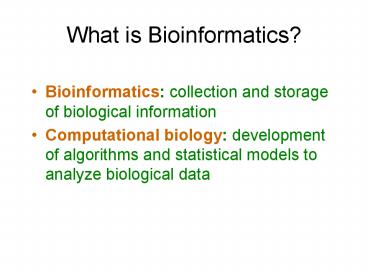What is Bioinformatics - PowerPoint PPT Presentation
Title:
What is Bioinformatics
Description:
... the need for storing and communicating large datasets has grown tremendously. ... EMBL www.ebi.ac.uk/embl/ The EMBL (European Molecular Biology Laboratory) ... – PowerPoint PPT presentation
Number of Views:48
Avg rating:3.0/5.0
Title: What is Bioinformatics
1
What is Bioinformatics?
- Bioinformatics collection and storage of
biological information - Computational biology development of algorithms
and statistical models to analyze biological data
2
Jobs for bioinformaticians
3
Databases make biological data available to
scientists
- As biology has increasingly turned into a
data-rich science, the need for storing and
communicating large datasets has grown
tremendously. - Nucleotide, protein sequences
- Protein structure
- Expression data
- Gene/protein networks
4
Nucleotide Databases
- EMBL www.ebi.ac.uk/embl/
- The EMBL (European Molecular Biology Laboratory)
nucleotide sequence database is maintained by the
European Bioinformatics Institute (EBI) in
Hinxton, Cambridge, UK.
5
Nucleotide Databases cont.
- GenBank maintained by the National Center for
Biotechnology Information (NCBI) contains Entrez
for accession to nucleotides, proteins,
annotations, etc. - www.ncbi.nlm.nih.gov/Genbank/
- UniGene a non-redundant set of gene-oriented
clusters www.ncbi.nlm.nih.gov/UniGene/
6
Protein Databases
- SWISS-PROT SWISS-PROT is a protein sequence
database to provide a high level of annotations
(such as the description of the function of a
protein, its domains structure,
post-translational modifications, variants,
etc.), a minimal level of redundancy and high
level of integration with other databases.
www.expasy.ch/sprot/
7
Protein Databases
- PIR
- http//pir.georgetown.edu/
- -The Protein Information Resource (PIR) is a
division of the National Biomedical Research
Foundation (NBRF) in the US. It is involved in a
collaboration with the Munich Information Center
for Protein Sequences (MIPS) and the Japanese
International Protein Sequence Database (JIPID).
Release 67.00 (31 Dec 2000) contains 198,801
entries.
8
Sequence Motif Databases
- Pfam
- www.sanger.ac.uk/Software/Pfam/
- Pfam is a database of protein families defined as
domains (contiguous segments of entire protein
sequences). For each domain, it contains a
multiple alignment of a set of defining sequences
(the seeds) and the other sequences in SWISS-PROT
that can be matched to that alignment.
9
3D-Structure Databases
- PDB
- www.rcsb.org/pdb/
- -The PDB is the main primary database for 3D
structures of biological macromolecules
determined by X-ray crystallography and NMR.
Structural biologists usually deposit their
structures in the PDB on publication, and some
scientific journals require this before accepting
a paper. It also accepts the experimental data
used to determine the structures.
10
How to get sequences?
- Entrez Database provides nucleotide and protein
sequences in different formats. - One of the formats is FASTA
11
FASTA FORMAT
- Each sequence begins with a description line gt
12
A protein in FASTA format
- gtHBA_ALLMI
- VLSMEDKSNVKAIWGKASGHLEEYGAEALEMFCAYPQTKIYFPHFDMSH
NSAQIRAHGKKVFSALHEAVNHIDDLPGALCRLSELHAHSLRVDPVNFKF
LAHCVLVVFAIHHPSALSPEIHASLDKFLCAVSAVLTSKYR - The first line is the description line, starts
with a character 'gt' shows that the description
line of a sequence follows the string following
the 'gt' and ending at the first space (' ') is
the sequence id (HBA_ALLMI).
13
A DNA sequence in Fasta
- gtX sequence
- ATGAATAGCACAGAGAGACCAAGAGAGAGAGAGAGACCCAGATATATCA
GATAGAGA
14
Why align sequences?
- Find evolutionary relationship between species
and/or genes. - Identify novel genes and define similar genes in
other species. - Study genomes and how they change.
15
Sequence Alignment
- Homology means that two (or more) sequences have
a common ancestor. - An example to sequence alignment
Sequence 1
Sequence 2
16
CLUSTALW A software for aligning sequences
http//www.ebi.ac.uk/clustalw/
17
Genome Databases
- www.ensembl.org
18
Genome Databases Gene Prediction
- Define the location of genes (coding sequences,
regulatory regions) - Gene prediction using software based on rules and
patterns. Find Open Reading Frames (ORFs), with
additional criteria for good start sequence for a
gene. - Gene identification through alignment with known
proteins and EST sequences (Expressed Sequence
Tags mRNA sequences). - Gene prediction through similarity with proteins
or ESTs in other organisms. - Gene prediction through comparison with other
genomes conserved regions are probably coding or
regulatory regions.
19
Genome Databases Annotation
- Annotation of the genes Compare with
genes/proteins of known function in other
organisms. - Functional classification. Broad groups of
functional characterization, such as 'ribosomal
proteins', 'nucleotide metabolism', 'signal
transduction'.
20
Genome Databases Evolution
- Evolutionary history
- Genome duplications
- Gene loss
21
Transcription Databases
- Microarrays can analyze 1000s of transcripts
simultaneously. - Allow analysis of genes that are high or low in
expression between normal and disease, for
example. - Microarray Databases contain expression data
(large amounts). - Stanford Microarray Database
22
Signaling Metabolic Pathways
- Analyze how genes/proteins interact and learn
about function of genes - KEGG Kyoto Encyclopedia of Genes and Genomes
- http//www.genome.ad.jp/kegg/































